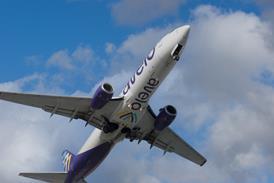Flight displays to dominate as manufacturer strives for look and feel of 777 cockpit
Boeing is expected to formally unveil by the end of the month the first detailed description of the finalised 787 flightdeck that will be dominated by five Rockwell Collins 230 x 305mm (9 x 12in) flat-panel primary flight displays.
Although designed to project the look and feel of the Boeing 777 flightdeck to enhance commonality and ease cross crew familiarity and training, the extra large 380mm diagonal displays, four across the instrument panel and one below on the centre pedestal, will provide up to 50% more display area than the slightly larger twin. The 777 flightdeck has six 200 x 200mm displays, five across the top and one on the centre pedestal.
The flightdeck will also come as standard with dual head-up displays manufactured by Rockwell Collins’ Flight Dynamics. These will be derivatives of the company’s Model 2200 units, but will be based on the 5000-series product line with liquid crystal display technology. Rockwell Collins also provides the 787 flightdeck display control panels as well as the multifunction keypads, and cursor control devices that will provide “soft switch” selection over the displays. Thales is supplying the 787’s integrated standby flight display (ISFD), which is expected to appear centrally on the display panel.
This LCD presents aircraft pitch and roll attitude, airspeed, altitude, heading and landing approach deviation data in a format almost identical to that of the primary flight displays. Other features will include the recently developed vertical situation display format, that shows a profile view of the planned flightpath of the aircraft, as well as terrain mapping.
The cockpit will have electronic flight bags and logbooks, as well as global positioning system-guided precision approach capability with a required navigation performance of 0.1nm. The flightdeck is designed for “mixed-fleet flying” and to make conversions relatively straightforward for crews coming from other Boeing types, particularly those with glass cockpit displays from the 757/767. Crews coming to or from the Next Generation 737 and 757/767 will require eight days of “differences” training, 10 days for the 747-400 to 787 and five for the 777 to the 787.
GUY NORRIS/LOS ANGELES
Source: Flight International























